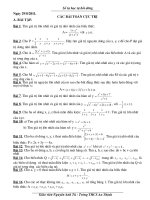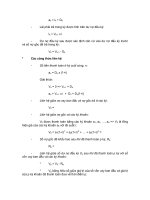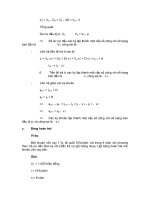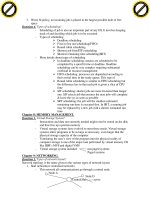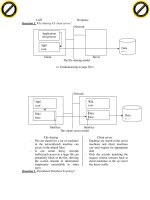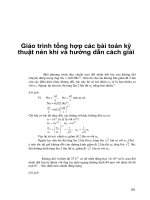IELTS writing task 1 samples band 8 9 and useful structures
Bạn đang xem bản rút gọn của tài liệu. Xem và tải ngay bản đầy đủ của tài liệu tại đây (727.18 KB, 22 trang )
Table of Contents
PORTFOLIO IELTS WRITING TASK 1
Part I: IELTS Essay samples task 1
1. Line graph
1.1.
International migration in UK
The chart gives information about UK immigration, emigration and net migration between 1999
and 2008.
Both immigration and emigration rates rose over the period shown, but the figures for immigration
were significantly higher. Net migration peaked in 2004 and 2007.
In 1999, over 450,000 people came to live in the UK, while the number of people who emigrated
stood at just under 300,000. The figure for net migration was around 160,000, and it remained at a
similar level until 2003. From 1999 to 2004, the immigration rate rose by nearly 150,000 people,
but there was a much smaller rise in emigration. Net migration peaked at almost 250,000 people in
2004.
After 2004, the rate of immigration remained high, but the number of people emigrating fluctuated.
Emigration fell suddenly in 2007, before peaking at about 420,000 people in 2008. As a result, the
net migration figure rose to around 240,000 in 2007, but fell back to around 160,000 in 2008.
Hanoi 2017
(159 words)
1.2.
Water consumption
The graph and table below give information about water use worldwide and water consumption
in two different countries.
The charts compare the amount of water used for agriculture, industry and homes around the
world, and water use in Brazil and the Democratic Republic of Congo.
It is clear that global water needs rose significantly between 1900 and 2000, and that agriculture
accounted for the largest proportion of water used. We can also see that water consumption was
considerably higher in Brazil than in the Congo.
In 1900, around 500km³ of water was used by the agriculture sector worldwide. The figures for
industrial and domestic water consumption stood at around one fifth of that amount. By 2000,
global water use for agriculture had increased to around 3000km³, industrial water use had risen
to just under half that amount, and domestic consumption had reached approximately 500km³.
In the year 2000, the populations of Brazil and the Congo were 176 million and 5.2 million
respectively. Water consumption per person in Brazil, at 359m³, was much higher than that in the
Congo, at only 8m³, and this could be explained by the fact that Brazil had 265 times more
2
irrigated land.
(184 words, band 9)
3
2. Bar chart
2.1.
Marriages and divorces
The first bar chart shows changes in the number of marriages and divorces in the USA, and the
second chart shows figures for the marital status of American adults in 1970 and 2000.
It is clear that there was a fall in the number of marriages in the USA between 1970 and 2000.
The majority of adult Americans were married in both years, but the proportion of single adults
was higher in 2000.
In 1970, there were 2.5 million marriages in the USA and 1 million divorces. The marriage rate
remained stable in 1980, but fell to 2 million by the year 2000. In contrast, the divorce rate
peaked in 1980, at nearly 1.5 million divorces, before falling back to 1 million at the end of the
period.
Around 70% of American adults were married in 1970, but this figure dropped to just under 60%
by 2000. At the same time, the proportion of unmarried people and divorcees rose by about 10%
in total. The proportion of widowed Americans was slightly lower in 2000.
(174 words)
4
2.2.
Levels of participation
The charts below show the levels of participation in education and science in developing and
industrialised countries in 1980 and 1990.
The three bar charts show average years of schooling, numbers of scientists and technicians, and
research and development spending in developing and developed countries. Figures are given for
1980 and 1990.
It is clear from the charts that the figures for developed countries are much higher than those for
developing nations. Also, the charts show an overall increase in participation in education and
science from 1980 to 1990.
People in developing nations attended school for an average of around 3 years, with only a slight
increase in years of schooling from 1980 to 1990. On the other hand, the figure for industrialised
countries rose from nearly 9 years of schooling in 1980 to nearly 11 years in 1990.
From 1980 to 1990, the number of scientists and technicians in industrialised countries almost
doubled to about 70 per 1000 people. Spending on research and development also saw rapid
growth in these countries, reaching $350 billion in 1990. By contrast, the number of science
workers in developing countries remained below 20 per 1000 people, and research spending fell
from about $50 billion to only $25 billion.
(187 words)
5
3. Table
3.1.
Rail networks
The table below gives information about the underground railway systems in six cities.
6
The table shows data about the underground rail networks in six major cities.
The table compares the six networks in terms of their age, size and the number
of people who use them each year. It is clear that the three oldest underground
systems are larger and serve significantly more passengers than the newer systems.
The London underground is the oldest system, having opened in 1863. It is also the
largest system, with 394 kilometres of route. The second largest system, in Paris,
is only about half the size of the London underground, with 199 kilometres of
route. However, it serves more people per year. While only third in terms of size,
the Tokyo system is easily the most used, with 1927 million passengers per year.
Of the three newer networks, the Washington DC underground is the most
extensive, with 126 kilometres of route, compared to only 11 kilometres and 28
kilometres for the Kyoto and Los Angeles systems. The Los Angeles network is
the newest, having opened in 2001, while the Kyoto network is the smallest and
serves only 45 million passengers per year.
(185 words)
7
3.2.
Goods consumer
The table below gives information on consumer spending on different items in
five different countries in 2002.
Percentage of national consumer expenditure by category - 2002
The table shows percentages of consumer expenditure for three categories of
products and services in five countries in 2002.
It is clear that the largest proportion of consumer spending in each country went on
food, drinks and tobacco. On the other hand, the leisure/education category has the
lowest percentages in the table.
Out of the five countries, consumer spending on food, drinks and tobacco was
noticeably higher in Turkey, at 32.14%, and Ireland, at nearly 29%. The proportion
of spending on leisure and education was also highest in Turkey, at 4.35%, while
expenditure on clothing and footwear was significantly higher in Italy, at 9%, than
in any of the other countries.
It can be seen that Sweden had the lowest percentages of national consumer
expenditure for food/drinks/tobacco and for clothing/footwear, at nearly 16%
and just over 5% respectively. Spain had slightly higher figures for these
categories, but the lowest figure for leisure/education, at only 1.98%.
(155 words)
8
4. Pie chart
4.2.
Diet (Cambridge 7, page 101)
The pie charts compare the amount of electricity produced using five different
sources of fuel in two countries over two separate years.
Total electricity production increased dramatically from 1980 to 2000 in both
Australia and France. While the totals for both countries were similar, there were
big differences in the fuel sources used.
Coal was used to produce 50 of the total 100 units of electricity in Australia in
1980, rising to
130 out of 170 units in 2000. By contrast, nuclear power became the most
important fuel source
in France in 2000, producing almost 75% of the country’s electricity.
Australia depended on hydro power for just under 25% of its electricity in both
years, but the amount of electricity produced using this type of power fell from 5
to only 2 units in France. Oil, on the other hand, remained a relatively important
fuel source in France, but its use declined in Australia. Both countries relied on
natural gas for electricity production significantly more in
1980 than in 2000.
(170 words)
9
5. Map
5.1.
Village of Chorleywood
The map shows the growth of a village called Chorleywood between 1868 and 1994.
It is clear that the village grew as the transport infrastructure was improved. Four periods of
development are shown on the map, and each of the populated areas is near to the main roads,
the railway or the motorway.
From 1868 to 1883, Chorleywood covered a small area next to one of the main roads.
Chorleywood Park and Golf Course is now located next to this original village area. The village
grew along the main road to the south between 1883 and 1922, and in 1909 a railway line was
built crossing this area from west to east. Chorleywood station is in this part of the village.
The expansion of Chorleywood continued to the east and west alongside the railway line until
1970. At that time, a motorway was built to the east of the village, and from 1970 to 1994,
further development of the village took place around motorway intersections with the railway
and one of the main roads.
(174 words)
10
5.2.
House design
The diagrams show how house designs differ according to climate.
The most noticeable difference between houses designed for cool and warm climates is in the
shape of the roof. The designs also differ with regard to the windows and the use of insulation.
We can see that the cool climate house has a high-angled roof, which allows sunlight to enter
through the window. By contrast, the roof of the warm climate house has a peak in the middle
and roof overhangs to shade the windows. Insulation and thermal building materials are used in
cool climates to reduce heat loss, whereas insulation and reflective materials are used to keep the
heat out in warm climates.
Finally, the cool climate house has one window which faces the direction of the sun, while the
warm climate house has windows on two sides which are shaded from the sun. By opening the
two windows at night, the house designed for warm climates can be ventilated.
(162 words, band 9)
11
5.3.
2 proposed super-market
The map below is of the town of Garlsdon. A new supermarket (S) is planned for the town. The
map shows two possible sites for the supermarket.
The map shows two potential locations (S1 and S2) for a new supermarket in a town called
Garlsdon.
The main difference between the two sites is that S1 is outside the town, whereas S2 is in the
town centre. The sites can also be compared in terms of access by road or rail, and their positions
relative to three smaller towns.
Looking at the information in more detail, S1 is in the countryside to the north west of Garlsdon,
but it is close to the residential area of the town. S2 is also close to the housing area, which
surrounds the town centre.
There are main roads from Hindon, Bransdon and Cransdon to Garlsdon town centre, but this is a
no traffic zone, so there would be no access to S2 by car. By contrast, S1 lies on the main road to
Hindon, but it would be more difficult to reach from Bransdon and Cransdon. Both supermarket
sites are close to the railway that runs through Garlsdon from Hindon to Cransdon.
(171 words)
12
6. Diagram
Forecast in Australia
The diagram below shows how the Australian Bureau of Meteorology collects up- to-theminute information on the weather in order to produce reliable forecasts.
The figure illustrates the process used by the Australian Bureau of Meteorology to forecast the
weather.
There are four stages in the process, beginning with the collection of information about the
weather. This information is then analysed, prepared for presentation, and finally broadcast to the
public.
Looking at the first and second stages of the process, there are three ways of collecting weather
data and three ways of analysing it. Firstly, incoming information can be received by satellite
and presented for analysis as a satellite photo. The same data can also be passed to a radar station
and presented on a radar screen or synoptic chart. Secondly, incoming information may be
collected directly by radar and analysed on a radar screen or synoptic chart. Finally, drifting
buoys also receive data which can be shown on a synoptic chart.
At the third stage of the process, the weather broadcast is prepared on computers. Finally, it is
delivered to the public on television, on the radio, or as a recorded telephone announcement.
13
(170 words)
14
7. Process
Water cycle
The diagram below shows the water cycle, which is the continuous movement of water on,
above and below the surface of the Earth.
The picture illustrates the way in which water passes from ocean to air to land during the natural
process known as the water cycle.
Three main stages are shown on the diagram.
eventually runs back into the oceans again.
Ocean water evaporates, falls as rain, and
Beginning at the evaporation stage, we can see that 80% of water vapour in the air comes from
the oceans. Heat from the sun causes water to evaporate, and water vapour condenses to form
clouds. At the second stage, labelled ‘precipitation’ on the diagram, water falls as rain or snow.
At the third stage in the cycle, rainwater may take various paths. Some of it may fall into lakes or
return to the oceans via ‘surface runoff’. Otherwise, rainwater may filter through the ground,
reaching the impervious layer of the earth. Salt water intrusion is shown to take place just before
groundwater passes into the oceans to complete the cycle.
(156 words, band 9)
Part II: Useful Structures
1. Từ vựng mô tả xu hướng, sự thay đổi
Các câu mô tả cho Figure 1:
• GM car sales increased significantly from $5,000 to $105,000 between 1960 and 2010.
• There was a significant increase of $100,000 in GM car sales, from $5,000 to $105,000,
•
•
•
•
between 1960 and 2010.
GM car sales saw a significant growth in GM car sales, from $5,000 to $105,000, between
1960 and 2010.
GM car sales registered a significant rise between 1960 and 2010.
GM car sales reached a peak at $105,000 in 2010.
GM car sales had an enormous climb of $100,000 between 1960 and 2010.
mild fluctuations
a marked rise
a peak
a dramatic decrease
a period of instability
a period of slight volatility
a significant increase
a leveling out
a partial growth
a sharp decline
a record high
a plateau
figures climbing back
figures remaining constant
2. Dùng giới từ chính xác
•
Dùng giới từ “to” khi mô tả sự thay đổi đến mức nào đó.
•
Dùng giới từ “by” khi mô tả sự thay đổi một khoảng nào đó.
•
Dùng giời từ “with” để nói về phần trăm, số lượng chiếm được.
•
Dùng giới từ “at” để thêm con số vào cuối câu.
3. Cách mô tả số liệu, phần trăm và phân số
.
.
a. 'double' (verb)
The number of unemployed people doubled between 2005 and 2009.
b. 'twice as...as/compared to', 'three times as...as/compared to'
•
There were twice as many unemployed people in 2009 as in 2005.
•
Twice as many people were unemployed in 2009 compared to 2005. 3. 'twofold',
'threefold' (adjective or adverb)
•
There was a twofold increase in the number of unemployed people between 2005
and 2009. (adjective with the noun 'increase')
•
The number of unemployed people increased twofold between 2005 and
•
2009. (adverb with the verb 'increase')
4. Cách mô tả số lượng
• The number of + Plural Countable Noun + Singular Verb Form
The number of people out of work fell by 99,000 to 2.39 million in the three months to
October.
• The amount of + Singular Uncountable Noun + Singular Verb Form
The amount of rainfall doubles between May and June.
• The proportion of + Countable or Uncountable Nouns + Singular Verb Form
The proportion of spending on furniture and equipment reached its peak in 2001, at 23%.
• The percentage of + Countable or Uncountable Nouns + Singular Verb Form
The percentage of people using their phones to access the Internet jumped to 41% in 2008.
• The figures for Countable or Uncountable Nouns + Plural Verb Form
The figures for imprisonment fluctuated sharply over the period shown.
5. Đa dạng hoá từ vựng (Vary your language)
This table presents some examples of how you can change percentages to fractions or ratios
Percentage
80%
75%
Fraction
four-fifths
three-quarters
70%
65%
60%
55%
50%
seven in ten
two-thirds
three-fifths
more than half
half
45%
40%
35%
30%
25%
more than two fifths
two-fifths
more than a third
less than a third
a quarter
20%
15%
10%
5%
a fifth
less than a fifth
one in ten
one in twenty
If the percentage are not exactly above, then you can use qualifiers to make sure your description
remains accurate. Here are some examples:
Percentage
77%
Qualifier
just over three quarters
approximately three quarters
49%
just under a half
nearly a half
32%
almost a third
This table presents some examples of how you can change percentages to other phrases:
Percentage
proportion / number / amount / majority /
minority
75% - 85%
65% - 75%
10% - 15%
a very large majority
a significant proportion
a minority
6. So sánh (Comparison)
The chart compares... In terms of the number of...
...is by far the most... OR ...has by far the highest number of...
The figures for... Tend to be fairly similar
In second place on the chart is...
The number of... Is slightly higher than...
Only four other countries have...
...all with similar proportions of...
...is the only country with a noticeably higher proportion of...
Superlative and comparative
Conjunction
However, In contrast, On the other hand, …
Whereas, While, Although, Despite of, …
7. Giải thích (Explaination)
Khi đưa thêm thông tin giải thích, bạn cần giới hạn số lượng từ để đảm bảo rằng
bài viết có thông tin chất lượng nhưng không vượt quá giới hạn từ (Reduced relative clauses) .
Ví dụ:
1. Both cities experienced a rise in the number of tourists coming in through their airports, which
reached a common level of 255,000 in July.
Rút gọn: Both cities experienced a rise in the number of tourists coming in through
their airports, reaching a common level of 255,000 in July.
2. Gold bar prices experienced a spectacular rise in November, which climbed to a
new peak of $625.
Rút gọn: Gold bar prices experienced a spectacular rise in November, climbing to
a new peak of $625.
3. In the first half of 2009, the attendance at the museum went into free fall, which
nose-dived to approximately 300,000 visitors.
Rút gọn: In the first half of 2009, the attendance at the museum went into free fall,
nose-diving to approximately 300,000 visitors.
4. Females also spend less time socializing and much less time than men on sport,
which allows them more time for studying.
Rút gọn: Females also spend less time socializing and much less time than men on
sport, allowing them more time for studying.
8. Ước lượng số (Expressing approximation)
We use words to express approximation when the point we are trying to describe is between
milestones on the graph.
Just under
Just over
Well under
Well over
Roughly
Nearly
Approximately
Around
About
Almost
Part III. Members’ Essays
1. Modes of transport used of travel to work in Melingen city, 1990-2000
The given graph illustrates the number of Melingen’s citizen who travelled to work in
various ways in three years 1990, 1995 and 2000. Units are measured in people.
Overall, there was not a significant change in the prior transport forms to work in Melingen.
Car was the most crucial and accommodating vehicle between 1990 and 2000 when bus and train
were also preferred than bicycle, walk and other transports.
In term of car, people in Melingen City used about 80 thousand in 1990, then the number
went down slightly in 1995 but recovered steadily in the next five years. Similarity, in 2000
citizens cycling to office has increase at about 8 thousand after falling a little in 1995, being under
one in ten of the number of car users.
Besides that, the number of bus and train users reached a peak at 25 thousand and 37
thousand respectively in 1995 when about 8 thousand was the figure for choosing other transports.
Undoubtedly, walking was seemed to be less popular over three years, with a gradual drop from
15 to 5 thousand in 2000.
(Nguyễn Thanh Hoài)
2. Modes of transport used of travel to work in Melingen city, 1990-2000
The bar chart gives information about how the number of means of transportation used to
commute to work changed in Melingen city in three separate years, namely 1990, 1995, 2000.
Overall, the use of modes of transportation to travel to work in Meligen city fluctuated
during three years given, while the only consistent trend was people who walked to work.
However, the figure of car was significantly higher than the others.
Over the period, car was the most popular vehicle in Melingen city. In 1990, that number
stood at about over 81,000 people, then slightly fell to approximately 80,000 in the next year
before reaching a peak at around 82,000 people in 2000. The figures for bus and train were far
lower than people used motor vehicle. Apart from a brief rise in 1995 to about 25,000, the
passengers commute by bus remained the same level at exactly 20,000. Train was used by 30,000
people in 1990, followed by almost 40,000 and 35,000 people in 1995 and 2000, respectively.
In contrast, the number of commuter to work on foot decreased gradually. In starting of
period, about 12,000 workers in that city walked to work place, after ten years, there was under
5,000. The figure for people who travelled to and from work by bicycle stabilized at about 10,000,
compared with a minimal reduction to around 8,000 in the middle period. Other kind of transport
were cited as the least common in Melingen city, fluctuated under 5,000 passengers, over the tenyear time.
(Nguyễn Phương Loan)
3. Modes of transport used of travel to work in Melingen city, 1990-2000
The provided program illustrates the figure of Meligen City’s citizens who use various types
of vehicles to work place in 1990, 1995 and 2000.
Overall, car was the major transportation in all three years surveyed, whereas bus and train
were minority. Walking and other were among the least-used ways of movement.
In terms of bus, the using figure remained fairly constant with 20000 in 1990 and 2000,
25000 in 1995. Car's data is the most remarked one with approximately more than 80000 users in
2000, which nearly tripled the figure of train users with 30000 people. In general, traveling by
bicycle was not a favourite choice in the time researched. Walking slightly decreased in number
and other transportation was minor form of vehicle with no more than five people during the
period of time surveyed.
(Nguyễn Minh Anh)
4. Exports from South-East Asia and sources of revenue for 1970 and 1995
The graphs illustrate four ways of getting revenue and three exports from South East Asia
between 1970 and 1995.
It is clear that the amount of money gained from exports in the South-East area of Asia
fluctuated in the period shown. Overall, there was a big change in sources of revenue for South
East Asia from domestic and exports to tourism between 1970 and 1995.
Looking at the line graph, timber had the lowest number of exports in 1970 while that of
other raw materials witnessed the highest figure. In 1977, there was a dramatically rise in the
number of manufactured products from about 22 million dollars to just under 35 million,
exceeding the figures for other raw materials, which had moderately increased to peak at
approximately 37 million then significantly declined. At the end of the period shown, in 1995,
manufactured became the most exported goods, with the timber remained the lowest of these
three.
In terms of the pie charts, the percentage of tourism doubled from just over a quarter in 1970
to became the most common source of revenue for South East Asia in 1995, at 54%. In contrast,
the figures for domestic and exports fell off gradually by 12% and 17% respectively.
(Lê Ánh Nguyệt)


